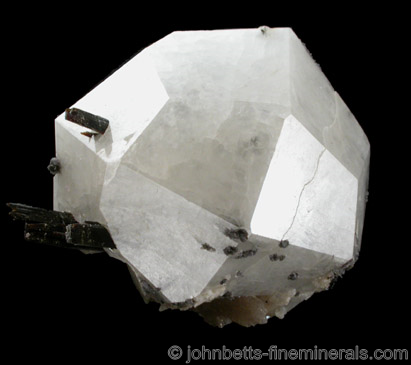The Mineral analcime

Analcime is a member of the zeolite group, and often occurs together with other zeolites. However, it is closely related in structure to the feldspathoid group, and is occasionally also classified as a feldspathoid together with the similar mineral Leucite. However, most mineralogical sources, including the IMA, classify Analcime only as a zeolite and not as a feldspathoid.
Although the crystal structure of Analcime appears isometric, its is usually off by only a fraction of an angle. This technically removes its classification from the isometric crystal system. Analyses of different Analcime crystals have yielded multiple results in crystal symmetry, with the most prevalent symmetry being tetragonal. However, truly isometric examples have been analyzed and do exist, thus making this mineral complex in its crystal classification. Due to Analcime's appearance as an isometric mineral, and the fact that isometric examples do exist, we have placed this mineral within the isometric group for classification.
The name Analcime is derived from the Greek term "an alkimos", meaning "not strong, in allusion to the weak pyroelectricity exhibited by this mineral.
Chemical Formula
NaAlSi2O6 · H2O
Color
White, colorless, and tan. Rarely yellow, brown, pink, or red from iron oxide staining.
Properties
Streak
Colorless |
Hardness
5 - 5.5 |
Transparency
Transparent to opaque |
Specific Gravity
2.2 - 2.3 |
Luster
Vitreous to dull |
Cleavage
None |
Fracture
Uneven |
Tenacity
Brittle |
Other ID Marks
1) Slightly pyroelectric.
2) Occasionally fluorescent white or light blue. |
Crystal Habits
Crystals form in distinctive, well-shaped trapezohedrons. Crystals are usually equidimensional, though they are occasionally distorted. Partial cubic faces are sometimes present on Analcime crystals, resulting in highly modified, distinctive crystals. Cubic crystals with modified trapezohedral faces also exist but are uncommon. Analcime crystals may be individual isolated crystals, interconnected crystals, or groups of multiple crystals on plates or in drusy form. Crystals masses may also occasionally form in veins.
Noteworthy Localities
Extremely large, single Analcime crystals were found in Russia near the Tunguska River, Evenkia, Siberia. Small gemmy colorless crystals, sometimes with modified cubic faces, come from the Cyclopi Isles off the coast of Aci Trezza, Sicily, Italy, which is the type locality for this mineral. Good Analcime crystals have also come from Buco dell'Inferno and Rio Fromm, in the Siusi Alps, Bolzano Province, Italy; and white crystals on a contrasting clay matrix from the Duingen Clay Pit, Alfeld, Lower Saxony, Germany.
In the U.S., the zeolite deposits of Paterson and Prospect Park, in Passaic Co., New Jersey, have produced outstanding crystals of Analcime in much abundance. Exceptionally large and opaque crystals in brecciated shale were found in the Chimney Rock Quarry, Bound Brook, Somerset Co., New Jersey. Small crystal groups of Analcime can be found in Wesley Hills, near Suffern, Rockland Co., New York; and good crystal plates were found in Cornwall, Lebanon Co., Pennsylvania. Several localities in the copper district of the Keweenaw Peninsula of Michigan have produced good Analcime crystals, especially the Phoenix Mine in Keweenaw Co. Well-formed Analcime crystals can be found at North Table Mountain, Golden, Jefferson Co., Colorado; and the Two Hug Quarry, Kings Valley, Benton Co., Oregon.
In Canada, very large white Analcime crystals are well-known from Mont Saint Hilaire, Quebec, especially in association with contrasting Aegirine and Serandite. Nova Scotia has several important localities: Nice colorless crystals can be found at Five Islands (especially Pinnacle Island); large white clusters at Wasson Bluff, Parrsboro; and pink, iron-stained Analcime from Cape Blomidon, at the Bay of Fundy.
Distingushing Similar Minerals
Leucite - Usually has a duller luster and less transparent, also rarely associated with other zeolites; otherwise very difficult to distinguish.
Garnet - Harder, usually a different color and environment.